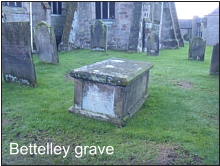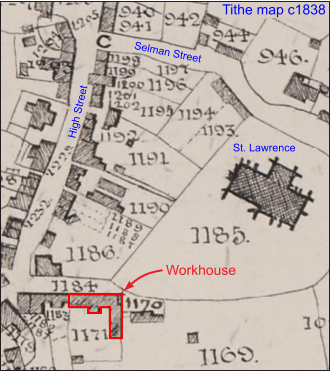Gnosall Workhouse (Summary)
See links below for detailed reading 1. Before the Union Until 1836, Gnosall Workhouse was independently run by the local churchwardens and elected overseers. The first known Workhouse at Gnosall (1733) was a converted Barn. By 1738 it was too small, and they were sending some of the poor to Penkridge. In 1774 they decided to build a new Workhouse at the bottom of the High Street (where the Stafford Road almshouses are), and in 1783 they bought a house near the church (on the site of the later school). In 1832 the dilapidated old building on Stafford Road was pulled down and two almshouses built there instead. The needy could apply for clothing, help with housing or e.g. seed potatoes and these were granted or not. Many of the needy were not living in the Workhouse. Thomas Bettelley was the Governor of the Workhouse from 1823. He is buried on the north side of the churchyard, with his first wife Ann and daughter Sarah Ann. The inscription reads “To the memory of Thomas Bettelley, for many years Govenor [sic] of Gnosall Workhouse … “ 2. Newport Union In 1834 Gnosall became part of Newport Union and from 1836 decisions were taken by the Board in Newport (three members each from Newport and Gnosall, and one each from the other 13 parishes). Gnosall Parish workhouse soon became a Poorhouse where children, the old and feeble and adults otherwise incapable of working lived. The Workhouse (for able-bodied adults) was in Newport. In January 1837 all the paupers from Newport, Gnosall and Lilleshall were reorganised. If they were judged fit to work, they went to Newport Workhouse; if unfit they were sent to Gnosall Poorhouse, and at this time the children went to Lilleshall. Of course this meant splitting families. Work usually meant picking oakum – taking old ropes apart to be used as caulking - although women might do domestic work and the men set to outdoor manual work. When Lilleshall Poorhouse was closed in 1837, work was done on the Gnosall Poorhouse to get it ready to take the pauper children. Gnosall Poorhouse Governors: The first governor and matron at Gnosall were James Bettelley (probably Thomas’s son) and his wife, 18361838. In 1838 they made a series of requests to improve the Poorhouse: among other things they wanted better windows, the ceiling of the schoolroom to be mended as it might fall down and hurt or kill a child, and more domestic help “as two of the children are extremely filthy in their habits”. It was under James Bettelley that the work of the inmates of Gnosall Poorhouse was limited to six hours a day (9-12 and 2-5) and they had permission to walk in the yard the rest of the time. James Bettelley was upset about the lack of useable rooms in the Poorhouse and complained privately to the Poor Law Commissioners in London. This got him into trouble with the Board and he was sacked for a financial irregularity. The second governor and matron were John and Mary Hawkins from Stafford (1838-1852). During their time, the Union ran out of space (1842) because of an increase in paupers. The Gnosall churchwardens offered the use of a house and premises in Gnosall rent free. This was accepted but it’s unknown where this was. In 1843 it was decided that “the Suet pudding day at Gnosall Poor House be on Sundays instead of Fridays so that the Poor thereby may be the better enabled to attend Church and that the Meat days be had on Fridays instead of Sundays.” In 1844 Mr Hawkins was allowed to get spelling books for the children and in 1845 walls were erected between the privies. In 1846 the Poorhouse got a dozen iron bedsteads, two ablebodied women were sent from Newport as domestic help and various repairs were done. In 1847 Mrs Elizabeth Selman was appointed schoolmistress to the children at the Poorhouse and in 1850 it was decided the children should be taken out into the county for exercise two or three times a week. In the 1850s the Board began to look at industrial training for the children and some land was acquired in Gnosall to train the boys in husbandry (an orchard next to the Poorhouse) but the closure of Gnosall Poorhouse also began to be discussed, in favour of a big new building in Newport. In 1852 John Hawkins was in trouble with the auditor over his claims of waste on joints of meat, and more seriously, he was found guilty of beating two paupers and locking them up in the “Dead House” – presumably the Poorhouse mortuary. The Hawkinses resigned. The third governor and matron were Cornelius Earle and Eliza Orton (18534) who were told they must marry before taking up their posts. The pauper children were to be vaccinated and a female servant to bake and wash at the Poorhouse was advertised for. In 1854 Mr Earle annoyed the Board by hiring a personal servant without their permission, and was then charged with beating the children severely, contrary to rules – one boy’s head was cut open with a stick and had to have medical attention. The Earles were discharged, along with the servant. For the remaining time Elizabeth Sellman and her son John, who was teaching the boys gardening, ran the Poorhouse, which was closed in 1855. While the new Workhouse was being built in Newport, the children were sent to Stafford. The Rev. John Till was active in trying to get pauper children outside the Poorhouse educated at local church schools. By 1857 the adult poor of Gnosall who couldn’t support themselves were sent to the new Workhouse on Audley Avenue in Newport, and the pauper children to a specialist industrial school at Quatt in Shropshire. Further detailed reading (Click a link below) 1. Gnosall Workhouse before the Union. From 1601 to 1834, the poor people of each district were looked after by the parish via overseers and churchwardens. 2. Public Meeting in Stafford 1836. In 1834 the New Poor Law Amendment Act centralised poor relief at a local level by setting up new administrative areas called Poor Law Unions. There was a lot of disquiet about this and an official came to address a public meeting in Stafford to explain how it would work. 3. Gnosall Poorhouse after the Union 1836-58. Gnosall came under Newport Union (not Stafford). Paupers capable of working were sent to Newport Workhouse and the old, feeble, and children went to Gnosall, whose building was then usually called the Poorhouse. This was closed down in 1854-5 when a new workhouse was built in Newport.




Click above for home screen




















